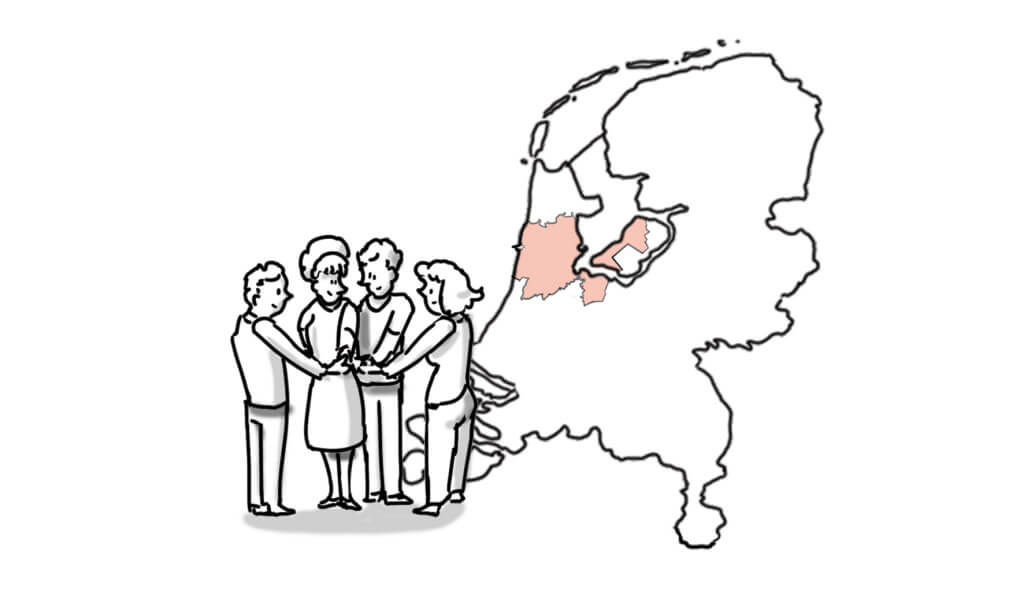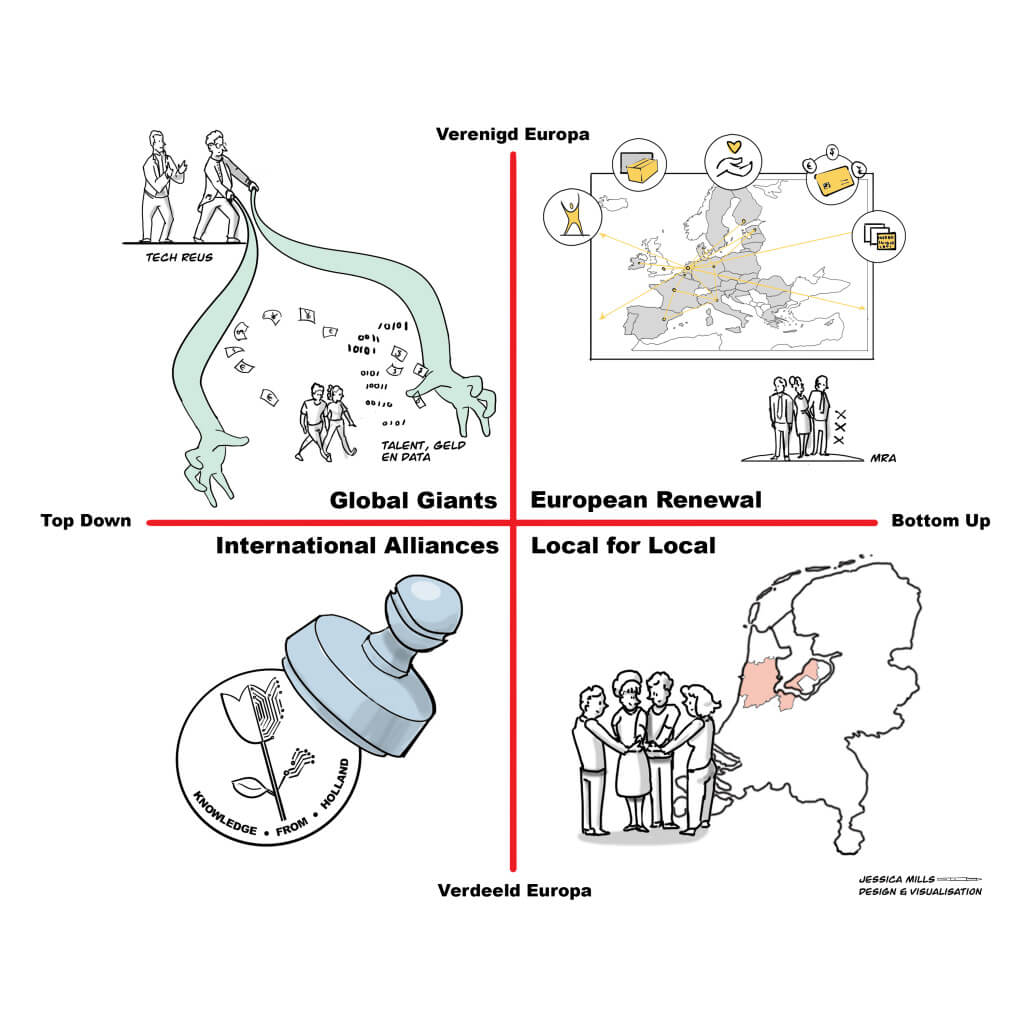Scenario: Local for Local
In the Local for Local scenario, a disintegrating Europe and a strong bottom-up society have led to a divided world in which ‘old’ institutions, such as government and large companies, have been rejected by citizens, who organise more themselves, shaping a sustainable, more locally oriented economy.
This scenario was last updated on 9 June 2020.

Keywords in this scenario:
- Local added value
- Self-sufficiency
- Enterprising/participating residents
- Closed market
- National strength and regional networks
Below you can see our illustration for discussion for the Local for Local scenario. Each scenario has one of these illustrations for discussions (there are links to the other three scenarios at the bottom of this article), visualising the differences between the scenarios, and the important aspects of each scenario. In combination with the text below, you can quickly gain an impression of the world that each scenario describes.

Divided Europe, bottom-up control
Lost ground due to discord
It is 2040. The world has been through troubled times. Trade wars and other conflicts have shrunk world trade. Discord has eroded the EU – when it came to the crunch, countries favoured the interests of their own people and their own economies. The divisions mean that the institutions in Brussels have been slimmed down and thus stripped of their power. At the same time, large European and international companies have been forced to play a supporting role on the world stage. Because of all the differences in national rules and standards, Europe is not a priority for the big tech companies. This slows down the introduction of their latest innovations. Talent either focuses on local issues or moves to power blocs such as Asia and America.
More attention to human scale and locality
Crises, layoffs and scandals have damaged public confidence in politics and in big companies. Citizens no longer accept major companies being given all sorts of advantages, while their profits flow to shareholders, and they can easily lay off employees. Big multinationals and traditional institutions, from governments to banks, are being given a smaller role. Citizens have started better organising themselves, resulting in a more decentralised and small-scale, locally-oriented economy revolving around innovative SMEs, flexible startups and social enterprises, often in local or regional networks. Open innovation is the starting point in these networks, and academic institutions and citizens are closely involved. Together they work on customised solutions, while limiting their dependence on players in other countries as far as possible.
What does this mean for the Amsterdam Metropolitan Area?
We are working to create the smart, green and healthy metropolis of the future. In the Local for Local scenario there are a number of strengths that help with this, and at the same time, there are also threats. What should and can we do to take the right steps in this scenario?
Technology serves people, not the other way around
Locally and nationally oriented networks of citizens and companies increasingly lead the way in the AMA. Technologies such as blockchain and 3D and 4D printing facilitate this new, locally-oriented network economy. This also makes for a wider spread of economic activities and focal points within the region, from Heemskerk to Lelystad. The rural areas, along with urban vegetable gardens, provide much of the region’s food supply and there is a strong mental connection between producers and consumers. The traditional main ports play a more limited or altered role in the regional economy. For example, the Port of Amsterdam has had to reinvent itself as a regional raw materials hub. Although new technologies allow for re-industrialisation on a smaller scale, protectionism and differences in regulations mean that employment remains limited. In addition, there has been a critical, ethical social discussion about the influence of technology, which is mainly seen as a support for people and work, not as a substitute. There is a strong emphasis on privacy, and large-scale data collection is a socially sensitive issue. In healthcare, local care networks, informal care and technology go hand in hand.
Moreover, each country follows its own course, prioritising the protection of its own citizens. Society funds a range of essential processes. Professions in education, care and distribution are highly regarded. Creativity, artisanship and entrepreneurship are more important than ever on the labour market. People who have not acquired these qualities from home or school find it hard to make their way in this society, in which a lot of self-reliance or connection with local networks is necessary. Companies and governments invest in talent from their own region and cooperate closely to provide them with ongoing work.
The AMA has excelled in strong bottom-up networks for decades with its ‘Amsterdam Approach’. In this climate, local and sustainable entrepreneurship thrives, and good ideas can quickly count on crowdfunding or other alternative financing. These networks maintain contact with similar ones elsewhere in the country and elsewhere in the world. Because competition between regions is less important, knowledge exchange has become easier, although it depends on personal and chance contacts. In 2040, voluntary work and neighbourliness is a staple aspect of the Amsterdam Approach. Insurance and charities are often organised in a cooperative form. A variety of local currencies are in circulation.
The mobility network focuses strongly on the AMA itself – with much attention for clean and safe transport between the urban centres, in combination with liveable streets with ample space for pedestrians and cyclists. In addition, there are connections within the Netherlands and a few other regions in Europe and beyond with which the AMA is ‘friends’. No international train connections have been established.
Local alliances pursue self-sufficiency and sustainability
Self-sufficiency is the guiding principle not only for many citizens, but also for companies. This is the result of shrinking world trade, which has jeopardised the security of supply of energy and raw materials. At a local level, citizens and companies want to organise their sustainable energy and other essential processes together, and a jumble of local initiatives has arisen. Both online and physical initiatives support a vibrant sharing and exchange economy. The circular use of raw materials is embraced by consumers, companies and governments, but the regional economic focus makes it a challenge to close cycles at the right level.
In order to accelerate the transitions, the challenge in the Local for Local scenario is to increase the scale of initiatives and thus make more impact. Because there is less competition on a global scale, the most cost-effective option is not always chosen. Due to the disappearance of European innovation funding and the investment power of large companies, different business models are needed to get investments off the ground. There is an increasing use of crowdfunding and crowdsourcing. A receptive government supports and facilitates citizens and their initiatives. Conversely, they have more direct say in government spending and policy.

The four scenarios for the Amsterdam Metropolitan Area
The Local for Local scenario is one of the four AMA scenarios.
Read the full article about the future scenarios. Or click directly below to read the other scenarios.
#slimgroengezond
Want to read more articles like this one?
Follow us daily on LinkedIn, X and sign up for our Board Update.
Read more
- Amsterdam UMC, OLVG and the Netherlands Cancer Institute will reuse each other’...
- The first meeting of this year’s Network Council was at Booking....
- How to ensure an effective health policy, focused on prevention? How can ...

